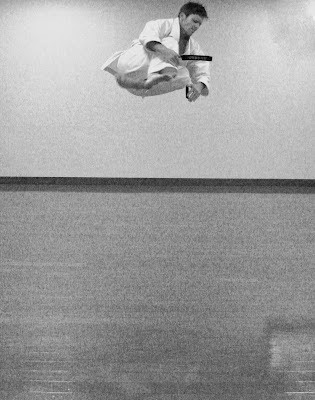I won’t provide sets and repetitions of my current regime presented here, as in this current routine, I’m tending to ‘decide on the day’ based on my condition. Hoping that everyone is well, and I wish you all the very best in your training. Osu, — AB.
基本
(KIHON)
Concentration on moving the center and gravity, fluid and relaxed arms, and ‘throwing out a heavy fist’. In sum, this renwaza is ‘kizami-zuki/gyaku-zuki’ and ‘gyaku-zuki/gyaku-zuki. Be sure to do this in a freestyle manner; that is, keep the arms loose, use the waist and legs fully, and engage your calves and gain maximum hip extension by rolling over the rear foot (with the heel raised and ball of foot planted).
2. The following four renzokuwaza are ‘legs followed by hands’. Besides correct technical form, trajectory and use of power, the key point from jiyu-dachi is to ‘attack with the sasae-ashi with both keri and tsukiwaza; that is ‘large scale tai no shinshuku’ twice. In sum, the snap of the kicking leg is not enough: ground power must be utilized. Likewise, koshi no kaiten is not enough for each gyaku-zuki. The expansion/stretch of the rear leg must underpin the rotation and seiken must impact just before the completion of the stance. After the completion of the tsuki, zenkutsu-dachi must be contracted by drawing up the rear leg and simultaneously returning to the freestyle kamae. Make sure the this is done with te-ashi-onaji (hands and feet simultaneously concluding together, and that it is done naturally and relaxed. Movements one and two of Heian Yondan provide a reference in this regard.
- Jiyu-dachi:
Chudan mae-geri keage kara chudan oi-zuki (zenkutsu-dachi).
3. From
heiko-dachi advance with migi mae-enpi into migi zenkutsu-dachi, return to
heiko-dachi and repeat on the opposite side. From here step sideward into
kiba-dachi with migi yoko-enpi return to heiko-dachi and repeat on the opposite
side. Step rearward with migi tate-enpi return to heiko-dachi and repeat on the
opposite side. On the spot rotate into a wide kosa-dachi with migi kaiten-enpi
return to heiko-dachi and repeat on the opposite side.
In all cases the body must be soft and, in particular,
‘shoulder snap’ must be utilized. With the exception of the kaiten uraken,
shime must be used to optimize a strict hikite. When doing the kaiten uraken,
the non-striking arm rests on the abdomen, as 'Zenwan mune mae suihei kamae' (like movements 2 and 6 of Tekki Nidan Kata) with the palm of
the fist facing downwards. Note that when utilizing tenshin—into the wide kosa-dachi—one
must not only spin but descend into the stance; thus, compress and stabilize. If you are observant, you will notice the use of the classical kakato-chushin here mixed with the freestyle 'tsumasaki methodolody'. Of course, the foundational method is the most important, but without freestyle it is incomplete.
- Zenkutsu-dachi: Jodan age-uke kara chudan gyaku-zuki.
- Zenkutsu-dachi:
Chudan soto-uke kara chudan gyaku-zuki.
- Zenkutsu-dachi:
Chudan uchi-uke kara chudan gyaku-zuki.
- Zenkutsu-dachi:
Gedan-barai kara chudan gyaku-zuki.
Focus on koshi no kaiten in zenkutsu-dachi: rotation/opening
the hips into hanmi for each ukewaza utilizing the rear axis; and
counterrotation into shomen for each gyaku-zuki using the axis of the lead leg.
Practice both advancing and retreating with fumidashi making sure that both uke
and tsuki have kime. Undetectably inhale on the uke and exhale on the tsuki.
The ‘karada no buki’ (weapon of the body) in closed fist
ukewaza are the wrists; therefore, ‘send your power from the ground to them’ as
you snap the shoulders/arms. Also pay special attention to the hikite on both
waza. Lastly, maximize the classical kakato-chushin and make sure that rear foot ‘sokuto’ is
firmly on the floor—especially when rotating into shomen.
I personally practice both the classic hanmi, around 45
degrees; but also, the large scale hanmi of 90 degrees, which I picked up from
Robert Sidoli Sensei a few years back. In either case, I always concentrate on
making perfect shisei (posture) throughout my transitions.
5. Idokihon: Kokutsu-dachi, Shuto-uke
Advancing and retreating in kokutsu-dachi with shuto chudan-uke and other waza; furthermore, transitions into zenkutsu-dachi with chudan tateshihon-nukite.
- Kokutsu-dachi:
Shuto chudan-uke.
- Kokutsu-dachi:
Shuto chudan-uke kara nukite (zenkutsu-dachi)
- Kokutsu-dachi:
Shuto chudan-uke kara kizami mae-geri soshite nukite (zenkutsu-dachi).
- Kokutsu-dachi:
Shuto chudan-uke kara kizami mawashi-geri soshite nukite (zenkutsu-dachi).
Emphasis on the conscientious weight distribution to the
rear leg, and ‘control of the rear foot’ moving in kokutsu and transitioning in
zenkutsu-dachi; also, kakato-chushin as to avoid ‘drifting the stance when
making nukite. In addition to these points, the shisei of the pelvis, torso,
neck and head, and both high and compact raising of the knee for both forms of
kizami-geri. Lastly, that within fumidashi the hips do not rotate to completion
until the end of the step; that is, shomen is maintained until the last moment. Noting Tanaka Sensei's classes, who is a specialist of the kizami-keriwaza, the spring of the ankles is of utmost importance.
五本組手
(GOHON KUMITE)
Attacks: (1) first set JODAN (Jodan oi-zuki); (2) second set CHUDAN (Chudan oi-zuki; (3) third set MAE-GERI (Chudan mae-geri keage); and (4) fourth set JIYU (a freely chosen attack on each step)
Defense and Counterattacks: (1) Any jodan ukewaza with a free
choice counter attack after the fifth and final defense; (2) Any chudan ukewaza
with a free choice counter attack after the fifth and final defense; (3) any
gedan ukewaza with a free choice counter attack after the fifth and final
defense; and (4) fourth set, free choice ukewaza in reaction to all five random
attacks with a free choice counterattack after the fifth and final defense.
The prime focus of when attacking is the seaming out of any
superfluous actions; in particular, pertaining to unsoku. Also fully utilizing
the hikite.
In the case of defense and counterattack, the focus point is
‘spontaneous best fit uke and hangekiwaza: especially in regards to maai and
optimal effect.
型
(KATA)
© Andre Bertel. Oita City, Japan (2022).


.jpg)

.jpg)










